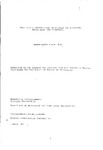REAL TIME MICROPROCESSOR TECHNIQUES FOR A DIGITAL MULTITRACK TAPE RECORDER
| dc.contributor.author | Donnelly, Terence | |
| dc.contributor.other | School of Engineering, Computing and Mathematics | en_US |
| dc.date.accessioned | 2013-11-20T14:19:32Z | |
| dc.date.available | 2013-11-20T14:19:32Z | |
| dc.date.issued | 1989 | |
| dc.identifier | NOT AVAILABLE | en_US |
| dc.identifier.uri | http://hdl.handle.net/10026.1/2775 | |
| dc.description.abstract |
Transport properties of a standard compact - cassette tape system are measured and software techniques devised to configure a low - cost,direct digital recording system. Tape - velocity variation is typically ± 10% of standard speed over tape lengths of 5 µm.with occasional variations of ±40%. Static tape - skew can result due to axial movement of the tape reel when it spools.Dynamic tape skew occurs and is primarily caused by tape - edge curvature with a constant contribution due to the transport mechanism.Spectral skew components range from 0.32 Hz to 8 Hz with magnitude normally within one 10 kbit/ sec- bit cell.The pinch roller works against the friction of the tape guides to cause tape deformation.Average values of tape deformation are 0.67 µm,0.85 µm and 1.08 µm for C60,C90 and C120 tape respectively. Parallel,software encoding / decoding algorithms have been developed for several channel codes.Adaptive software methods permit track data rates up to 3.33 k bits/sec in a rnultitrack system using a simple microcomputer.For a 4 - track system,raw error rates vary from 10ˉ⁷ at 500 bits/sec/track to 10ˉ⁵ at 3.33 kbits/sec/track.Adaptive software reduces skew - induced errors by 50%.A skew - correction technique has been developed and implemented on an 8 - track system at a track data rate of 10 k bits/sec. Real - time error correction gives a theoretical corrected error rate of 10ˉ¹¹for a raw error rate of 10ˉ⁷. Multiple track errors can cause mis - correction and interleaving is advised. Software algorithms have been devised for Reed - Solomon code. With a more powerful microprocessor this code m ay be combined with the above techniques in a layered error-correction scheme. The software techniques developed may be applied to N tracks with an N - bit computer.Recording density may be increased by using thin - film,multitrack heads and a faster computer. | en_US |
| dc.description.sponsorship | British Broadcasting Corporation | en_US |
| dc.language.iso | en | en_US |
| dc.publisher | University of Plymouth | en_US |
| dc.title | REAL TIME MICROPROCESSOR TECHNIQUES FOR A DIGITAL MULTITRACK TAPE RECORDER | en_US |
| dc.type | Thesis | |
| plymouth.version | Full version | en_US |
| dc.identifier.doi | http://dx.doi.org/10.24382/1524 | |
| dc.identifier.doi | http://dx.doi.org/10.24382/1524 |
Files in this item
This item appears in the following Collection(s)
-
01 Research Theses Main Collection
Research Theses Main


